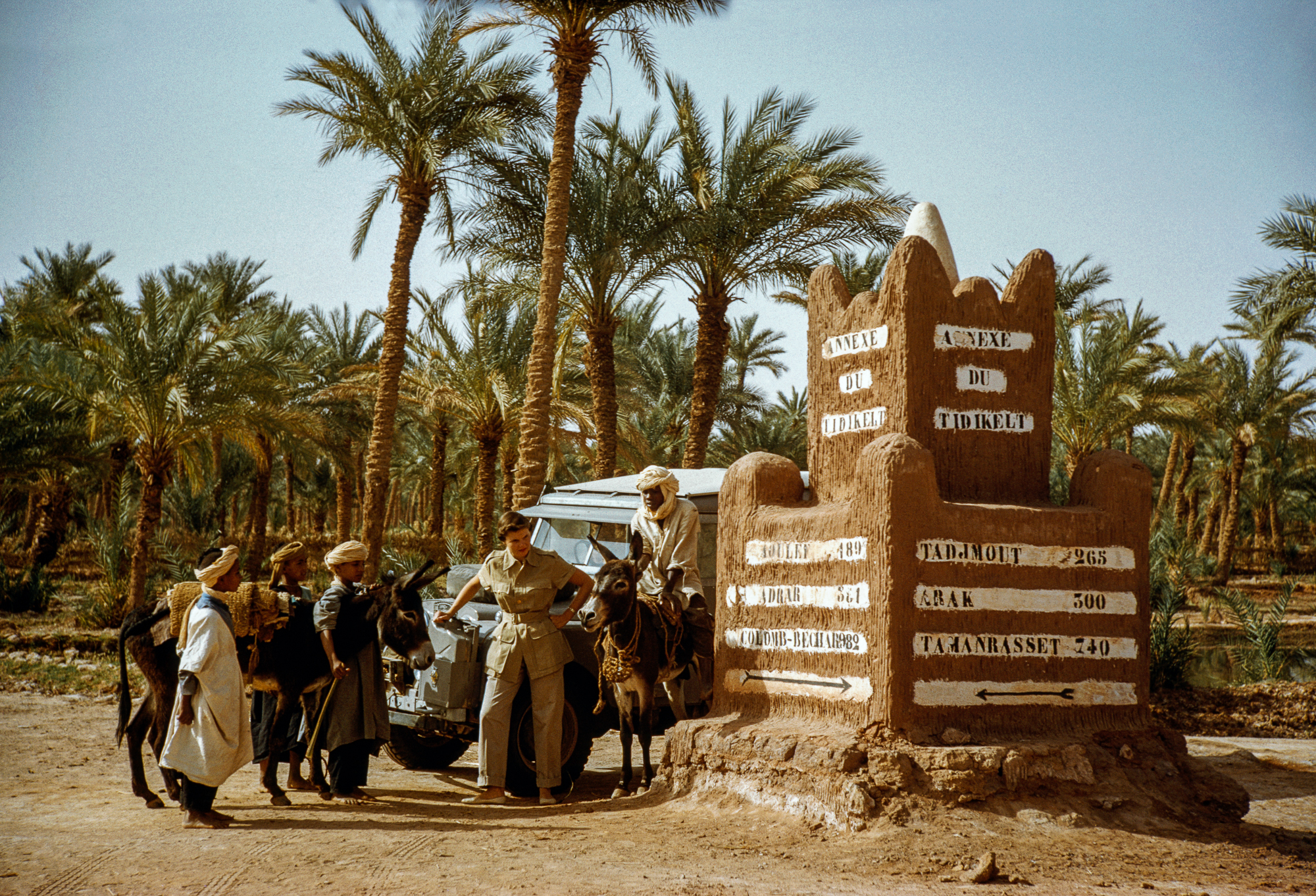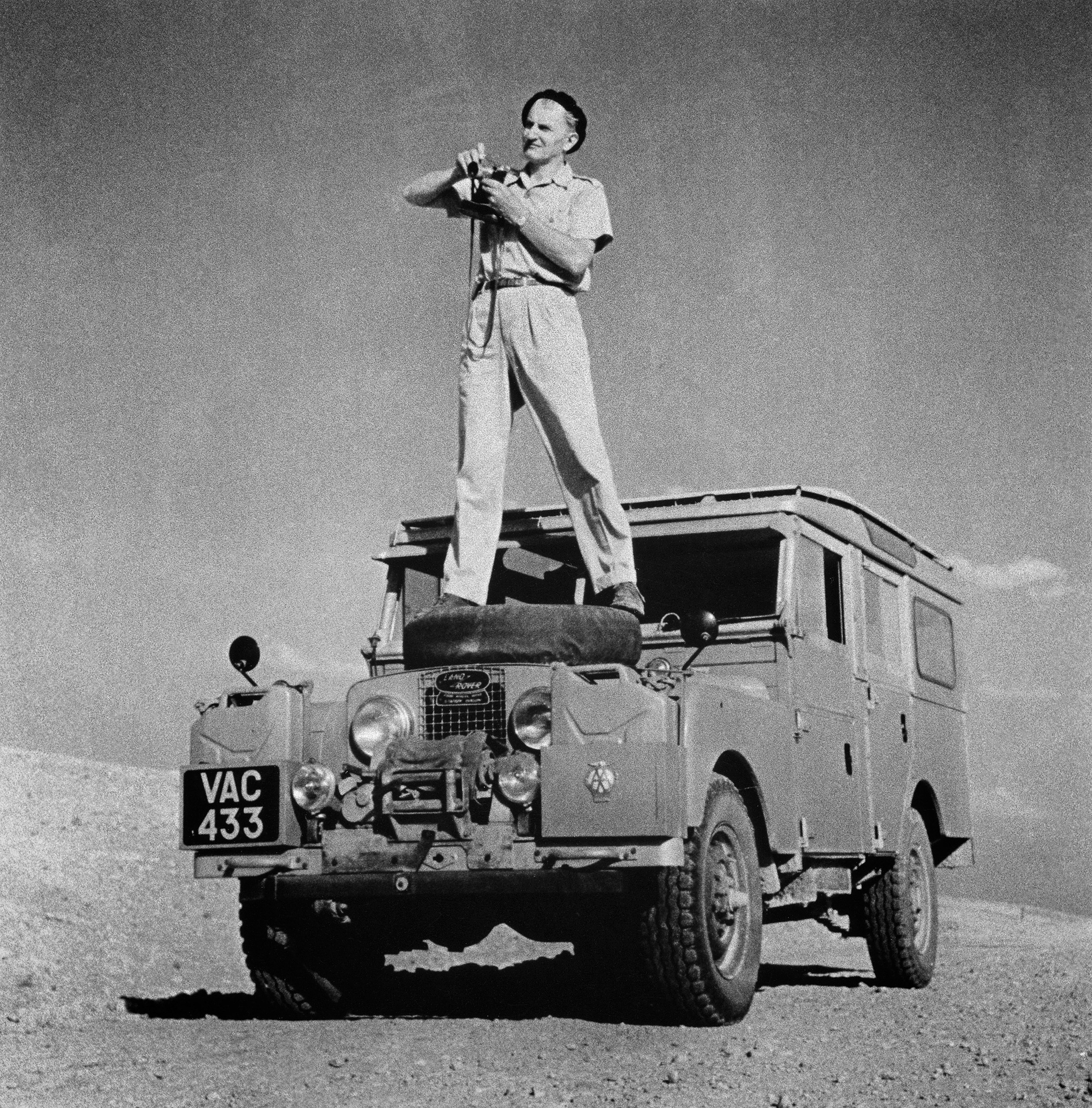Photography by George Rodger
“George Rodger belongs to the great tradition of explorers and adventurers. His work is a moving testimony through time and space.” – Henri Cartier-Bresson
One photograph from the 1957 Trans-Sahara Expedition stands out from the rest. It isn’t of George Rodger standing on the hood of his 107-inch Land Rover Series One station wagon, camera in hand, posing with authority, but a shot with his arms raised, blinded by a raging sandstorm. Jumpsuit billowing, he shields his eyes from fierce winds permeated with sand swirling in the Algerian desert. The scene reveals the struggle—where he shined, distracted from pain, far from the horrors of war, where he often sought refuge: Africa.
Rodger’s images communicate something I didn’t initially understand. National Geographic magazine ran a generous collection of full-page photographs from the 1957 Trans-Sahara Expedition, and for good reason. Soaring Saharan dunes appear perfectly painted by watercolor; portraits of a hooded Tuareg matriarch celebrate her delicate gestures; Jinx Rodger smiles at the camera, trusting her scissor-wielding husband with a haircut in the African bush. What made Rodger such a great photojournalist, and why Life magazine chose him as one of its trusted war correspondents, was his ability to freeze time, capturing scenes that grip the heart, revealing an intimate story of humanity and, at times, inhumanity.
Carole Naggar, author of George Rodger, An Adventure in Photography, 1908-1995, suggests that tough conditions explained the Brit’s desire to roam and allowed him “to forget himself and his conflicts through action.” Recurring depression and disabling headaches followed his war coverage through 62 countries documenting over 18 war campaigns. His most celebrated work featured scenes from the London Blitz, D-Day Normandy landings, West Africa with the Free French, and the liberation of the Bergen-Belsen concentration camp, among others. But they came at a price. “When I discovered that I could look at the horror of Belsen—4,000 dead and starving lying around—and think only of a nice photographic composition, I knew something had happened to me and it had to stop,” he said. After 1949, he never photographed war again.
There are places we go to heal, create, cope, feel alive, or rekindle our sense of joy. Rodger found peace within the natural world, and something about Africa “soothed his tortured soul.”(1) After Belsen, he felt disdain for Western civilization and called to the Africa of “great tribal kings—Mutesa and Kansazi—of wild beasts, and of men who were fierce, naked, uninhibited and right deep close to the earth.” (2) Simultaneously, he understood what his presence meant. “He was an Englishman in Africa,” Naggar writes, “loving what was most authentic about the country, yet understanding that by their very presence, white men—including himself—were changing the culture.” Nonetheless, he was determined to visit tribal Africa. “It was the only way I could get rid of the stench of war that was still in me.”(3)
By 1957, George was no stranger to the continent, having endured an arduous 4,000-mile 1940 Desert Campaign for Life magazine in an Oldsmobile and a Chevy pickup, completing various trips through Algiers, Tunisia, and Libya on assignment in 1947, and tackling a yearlong expedition from Johannesburg to Cairo in a truck, trailer, and station wagon from 1948 to 1949. This time, he was investigating oil-drilling projects and new French highways in the Sahara with some National Geographic assignments thrown into the mix.
“During that trip Rodger recovered his spirit,” writes Naggar. “He worked nonstop, both in color and black and white . . . producing beautiful photographs of the deserts, the fortress of Timimoun, the Tuareg people, and flash floods at Ghardaia.” The 90-day, 4,000-mile Trans-Sahara Expedition, undertaken with his second wife, Jinx, transported Rodger back to his World War II Sahara trips. Stone cairns, bleached camel bones, and empty whiskey bottles acted as road markers.

Only 600 miles of paved roads existed in the Algerian Sahara at that time; the roads that did exist left something to be desired. George’s diary entry on May 9, 1957, referenced a 14-hour driving day on “the worst road in all the Sahara,” which no doubt honed their recovery procedure involving digging a hole in front of each wheel, filling the space with rocks (if available), laying down sand tracks, and engaging four-wheel drive before letting out the clutch (slowly) and hoping for the best. Fesh-fesh, described by Jinx in National Geographic’s “Sand in My Eyes,” was something to be reckoned with and the “peril of perils—a dust fine as talcum powder and treacherous as a bottomless swap.”
Named after a Swahili phrase for “very good,” Mzuri was the Rodgers’ newest model Land Rover station wagon, outfitted with four-wheel drive, oversized tires, double roofing, air-conditioning vents, and a heater. George and Jinx packed extra fuel and a short-wave radio—the usual items. Their belongings filled a four-page-typed list prepared for customs officers along the way. “George had nearly died of thirst on his second Sahara crossing,” Jinx wrote in “Sand in My Eyes,” “so this time we made sure we were well equipped.”
In 1941, Rodger found himself in the Saharan region of Chad, roasting beneath a tarp fixed to a Chevrolet perched on four petrol drums, stripped of its broken transmission and rear axle. Well into his first foreign assignment for Life magazine, he chased the Free French, who were fighting the Italians under Charles de Gaulle. Currently, however, he was trapped in a wadi between Faya and Abecher, where no motor vehicle had ever crossed, and caravans were rarely spotted. Fifty miles from water, 100 miles from inhabited settlement, and 750 miles from the nearest garage, the sun was unbearably hot, and the feeling of loneliness extreme. His companions, a “rather dubious” baron who acted as an interpreter cum gold mine owner, set off with hired guides Faya and Anacolet to track down a scrap heap of a Chevrolet they had spotted earlier in the desert mission. Perhaps the transmission and back axle were still intact? George, a guide named Ngena, and Barnaby, their cook, interpreter, and mechanic, remained behind with two days’ worth of water.
“The third day went by without the Baron putting in an appearance,” Rodger wrote in his memoir, Desert Journey. He was on the verge of desperation—only a few drops of water remained. They hatched a plan to walk 50 miles to the well at Yoggoum the following night, but Rodger woke up with sand in his ears, coating the inside of his nostrils and ground between his teeth. It was impossible to reach the well now; a sandstorm erased the remaining tire tracks overnight.
Tongue dry, George divided the remaining spoonfuls of water between the three men and sat to write a few letters. “Even if I could not mail them myself,” he wrote, “somebody else probably would—eventually.” After weeks of battling across the desert, missing his scoop in Kufra by 24 hours, and snapping his two front teeth off after being thrown against the Chevrolet’s windshield, Rodger took in the rose-tinted desert, quiet and peaceful. Indeed, it was “hardly the place in which to die of thirst.”
On an early summer morning in July 1942, George Rodger arrived at the Lexington Hotel in New York City at the end of what Life magazine described as “the longest journey of any photo-reporter or newswriter in this or probably any other war.” He had covered 75,000 miles from Scotland to Douala, across the Sahara, and into Ethiopia, Iran, Syria, Libya, India, China, and Burma. Delirious and feverish, the Baron eventually arrived with spare parts for the broken Chevrolet and a supply of water. “He had made it,” Naggar writes, “but so many war correspondents, his friends and colleagues, had not. The pictures he had taken were now haunting him with perfect, painful clarity.” He was exhausted, his hair had turned grey while he was gone, and nightmares filled his nights with snipers and gunfire. Still, he felt adrift and purposeless without deadlines and assignments.
Some of the most powerful images from the Desert Campaign remained solely in his mind. In central Sudan, Rodger encountered the Nuba people, who have lived in South Kordofan since the 26th century and practice traditional wrestling and Kau-Nyaro bracelet fighting. The warriors had never seen a photographer and quickly raised their spears when Rodger brought out his camera, forbidding him to take any pictures. Nearly a decade later, the Sudanese government granted George permission to photograph the Nuba tribespeople during his Cape-to-Cairo journey. The photos, captured with George’s trusty Leica rangefinder, first appeared in National Geographic in 1951. The collection has become one of his most well-known and created a cultural record prior to the oppression, displacement, and humanitarian crisis faced by the Nuba people due to the Second Sudanese Civil War nearly four decades later.
Rodger returned to Africa 15 times between the 1940s and 1981, continuing to embrace tough conditions and believing in the importance of documenting an Africa on the brink of change. Eager to photograph endangered wildlife, he and Jinx observed large game in several reserves of Kenya, Uganda, and Congo between 1957 and 1958. They co-wrote “Where Elephants Have Right of Way” for National Geographic, a 28-page article with captivating text and sublime full-page images of Karamoja women gathering around the Rodgers’ Land Rover, elephants backed by a snow-capped Mount Kilimanjaro, and Napore spearmen in northeastern Uganda performing ceremoniously before a hunt.
Nearly 30 years after the 1957 Trans-Sahara Expedition, Rodger traveled to Africa on what would be his last visit to the continent before his death. By then, Naggar writes, “he was striving at all costs to avoid recording discord and suffering in his work. The inspiration and poetry that had been so potent in Rodger’s earlier photographs were now rarely found in his work.” Depression and loneliness had become constant companions.
But at age 70, Rodger was invited to photograph the Maasai—an experience that had been on his mind since 1942. Numerous attempts were thwarted by civil wars, drought, famine, and the Maasai themselves—their trust had to be earned. Eventually, a Maasai friend, Yusef, invited George on a whirlwind trip to photograph the warrior tribe. A few days later, the two left Nairobi, crossing the savanna in a Land Rover. George was about to witness the circumcision ceremony of an adolescent Maasai warrior—an occasion previously unseen and unphotographed by any white man. Back home in England, Rodger processed the images. The story was his best since the Nuba in 1949. “He may have sensed as he was making these images that these would be his last pictures of the place he loved most,” writes Naggar. “This was Rodger’s farewell to Africa.”
***
In 1947, George Rodger joined Robert Capa, Henri Cartier-Bresson, David Seymour, and William Vandivert in founding the Magnum Photos agency, a cooperative described by Cartier-Bresson as a “community of thought, a shared human quality, a curiosity about what is going on in the world, a respect for what is going on and a desire to transcribe it visually.” A generous collection of Rodger’s works can be found at magnumphotos.com and the International Center of Photography.
According to the Magnum Photo website, the Rodgers’ Series 1 station wagon, Mzuri, is now owned by Land Rover specialists David and Janelle D’Arcy in Australia.
***
- Naggar, Carole. George Rodger, An Adventure in Photography, Syracuse, 2003.
- Rodger, George. Africa on a Shoestring, Beirut, February 1955.
- Naggar. George Rodger, An Adventure in Photography.
Our No Compromise Clause: We carefully screen all contributors to ensure they are independent and impartial. We never have and never will accept advertorial, and we do not allow advertising to influence our product or destination reviews.


